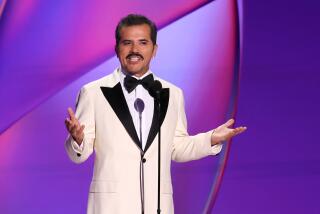COUNTERPUNCH : TV’s Definition of ‘Minority’ Too Narrow
- Share via
On its face, Howard Rosenberg’s commentary, “The Invisible Man Is Alive and Well” (July 25), seems like a well-intentioned criticism of the failure of the four major networks to feature even one lead person of color in any of their 26 new fall series.
In reality, however, it points out the blind spots not only of the writer, but also
of the television and movie industries.
First of all, let’s get something straight: “Minorities” do not equal “blacks only.” They also include Hispanic, Asian, Arab and Native Americans. In his article, however, Rosenberg uses the term interchangeably with African Americans. Indeed, all of his examples of “minorities” in television shows are of African Americans.
Like Hollywood, Rosenberg seems to believe that adding one black to otherwise all-white shows makes them “integrated” or “ethnically diverse.” Since when have black and white adequately represented the colors of the rainbow, let alone the potential color TV sets gave us decades ago to experience the world in its many glorious hues?
Because he believes “ER,” which features only white and black regulars, is “ethnically diverse,” Rosenberg says he can’t believe “ER” producer John Wells is responsible for NBC’s upcoming “The West Wing,” which includes only white leads.
Hell, it’s what I’ve come to expect from Wells: Even though one out of every six physicians in the United States is of Asian descent, shows like “ER,” “Chicago Hope” and the recently canceled “L.A. Doctors” do not include one regular Asian American doctor.
Where are the Asian American lawyers? We waited eight years for one to join the cast of “L.A. Law.” Never happened. “The Practice”? Not yet. Asian Americans, one-third of San Francisco, are absent from shows like “Suddenly Susan” except as comic-relief racial caricatures. And Latinos, 11% of the U.S. population, are rarely seen anywhere.
There is no excuse to exclude any ethnic group from major metropolitan cities.
In 1997, one network trying to revive “Hawaii Five-O” cast white men in the three main leads, offering the fourth slot (a glorified secretary) to a half white-half Asian woman. This taking place in a state that is 62% Asian-Pacific Islander. When I later met with a vice president of that network, he admitted they’d considered getting an African American to play the head of “Five-O,” even when blacks make up less than 2% of Hawaii’s population.
Again, Hollywood mentality as usual: “Minorities” equals “blacks.” What’s more, Hollywood--and Rosenberg-- seems threatened when more than one ethnic group is included in any television show. In 1995, while reviewing the Fox series “Space: Above and Beyond,” which featured Filipino American and African American regulars, Rosenberg snidely dismissed the show for its “politically correct casting.” This from the same writer now lambasting the networks for not including enough “minorities” in its programming?
The only way things will change is if the powers-that-be become fully comfortable with the notion that television should reflect not only the diversity of people in everyday life, but the diversity of the jobs and positions they hold as well. When they realize the different story-line possibilities this opens up, they’ll understand that including people of color in their casts is not a creative imposition--it’s a creative opportunity.
“Martial Law,” starring Sammo Hung, Arsenio Hall and Kelly Hu (a majority minority cast), regularly beats its competition Saturday nights. Lucy Liu got an Emmy nomination for “Ally McBeal.” The increasingly popular “Nash Bridges” features Latinos Cheech Marin and Jaime Gomez. In these cases and many more, the networks didn’t do us a favor by including people of color in their shows--they did themselves one.
Guy Aoki is founding president of Media Action Network for Asian Americans, an organization that monitors the media and advocates balanced coverage and depiction of Asian Americans.
Counterpunch is a weekly feature designed to let readers respond to reviews or stories about entertainment and the arts. Please send proposals to: Counterpunch, Calendar, Los Angeles Times, Times Mirror Square, Los Angeles CA 90053. Or fax: (213) 237-7630. Or e-mail: Counterpunch@latimes.com. Important: Include full name, address and phone number. Please do not exceed 600 words. We appreciate all proposals and regret that we cannot respond to each.
More to Read
The complete guide to home viewing
Get Screen Gab for everything about the TV shows and streaming movies everyone’s talking about.
You may occasionally receive promotional content from the Los Angeles Times.






